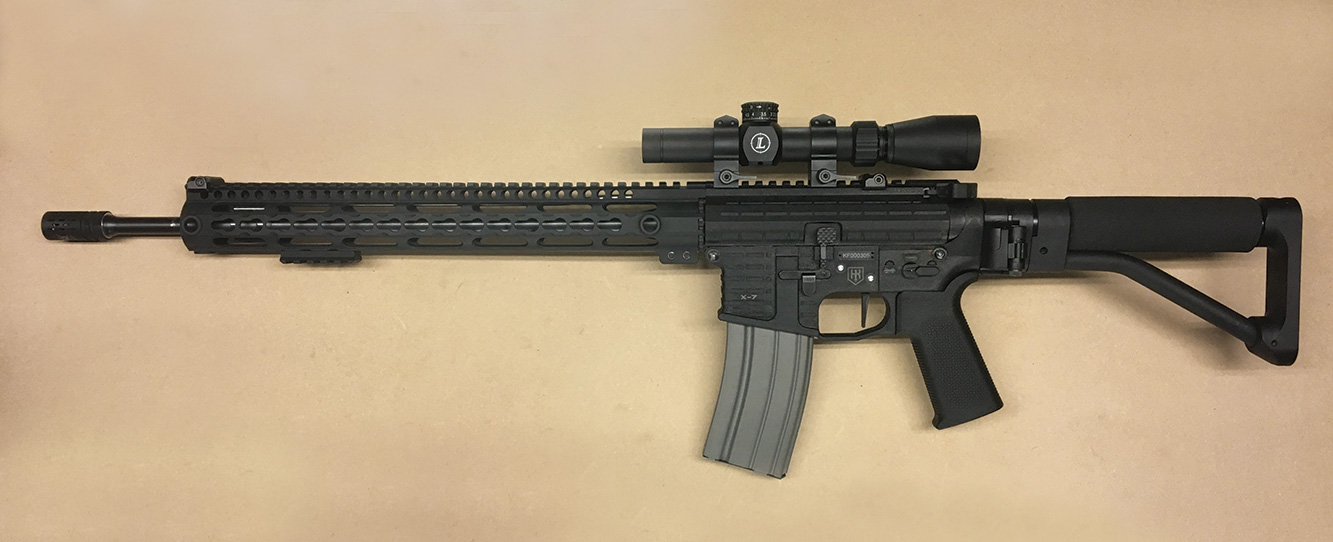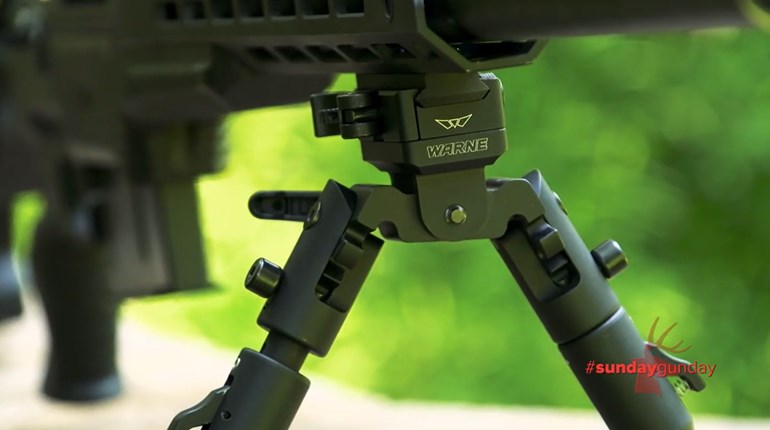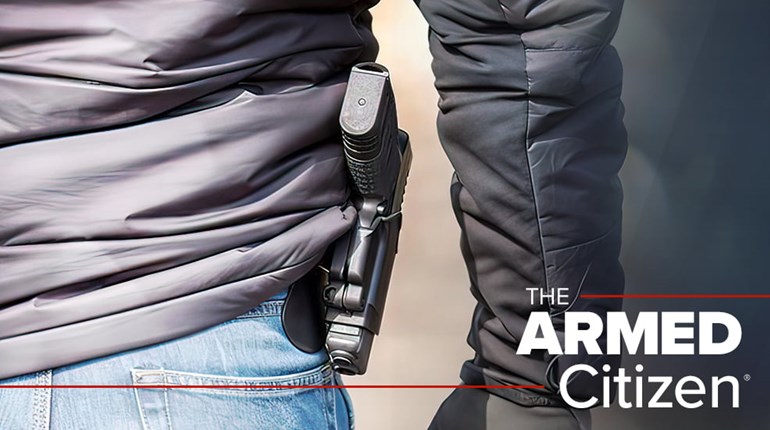
We’re sad to say it in some respects, but very glad in others: Our “maneuverable” MSR is done. Twelve installments ago, we set out to build a “light” (under eight pounds with an optic, loaded 20-round magazine and back-up sights) and “short” (stowed length under 30 inches) rifle on the Stoner/Sullivan/Fremont pattern. As we said here, it was fully assembled; now, it’s been thoroughly shot.
What Worked
Given what a pleasant-shooting rifle this has turned out to be, the list here is long. Still, there are particular standouts: Our upper/lower polymer pair from Kaiser US shows no material—no pun intended—weaknesses that we can see. Given how much we’ve been in and out of the rifle for various reasons, we’d have expected hints of trouble by now if there were going to be any. But so far, nada: The KNS Precision pins are superlatively snug in their takedown/pivot, and trigger roles, and the overall fit is a delight.
We were “in” the lower a lot partly because of our trigger, a Timney recommended to us by Brownells. Don’t read into that negatively: This is one of our favorite features of the finished rifle. What made it a little labor intensive, however, was some well-advised ultra-caution from Timney—they recommend the installation of a steel plate underneath the trigger body when a polymer lower is in use, but we had to thin the plate by .009 inches. By hand, it took a while. The results were worth it. Roy Hill at Brownells had recommended the straight lever, 4-pound version, and it’s a dream. Between the pins, plate, precise hole position and Timney architecture, the safe, durable press feels a lot closer to three pounds than four, and gets uniform “ahhhhhs” from everybody who shoots the rifle. A peach, by any standard.
Our Law Tactical folder mechanism had us in the rifle a bunch too. The mechanism itself is great; what proved a little tricky was getting our Sharps Rifle Company BCG (or any other BCG, for that matter, and we tried an even half-dozen to be sure) to run smoothly through the seam. No hack there on the SRC, either—their “diamond-like coating,” tool steel rig and Relia-Bolt is still a favorite on a very short list.
In the end, a slight chamfer on the forward face/interior edge of the Law fitting that attaches the assembly to the lower did the trick. Do yourself a favor and break this edge before assembly. The Law fitting is incredibly secure, and—trust us on this—you don’t want to disassemble/reassemble.
Our entry-length ARFX skeleton stock is proving out too. Because the Law adds some length, the combo isn’t as short as you might expect. For us, the mount has become natural very quickly. We’ve left the included pad off the butt for two reasons. The first is the simplest: We don’t miss the length.

The second is subtler, but has implications for every rifle. Butt pads aren’t fabricated from a consistent material in terms of “tack”—some are stickier than others. While we don’t mind the supplied version, we don’t figure 5.56 recoil demands one. Ergo, we skip the risk of catching rubber on garments and a resulting “fouled” mount of the rifle. It’s a pet peeve, we admit, but avoided altogether by eschewing the pad.
What Didn’t
Right off, recognize we’re using “didn’t” advisedly. As a whole, the concept and function are working even better than we hoped—a huge credit to the components and the good advice we got from many sources along the way.
But perfect? Well, no.
Mainly, this had to do with sighting. Our little Leupold is certainly not the problem. This thing is actually crazy good, and especially for $389 MSRP. We picked it for the (obviously) good reputation that follows the marque, but also, and especially, for light weight and trim proportions. Check, and check.
In terms of optical performance, the compromises, if any, are so tiny we’ve yet to find them. It’s bright, clear, easy to adjust and utterly capable within the sensible range of the cartridge. Candidly, we’ve even slung the rifle around more than normal, but no luck: This little guy is holding zero just fine, and we’re having no trouble with both eyes open at 1.5x.
What we’ve finally decided to change, however, is our mount. Not that our favored Warne QDs aren’t “holding their mud,” but rather because our attempt to buy back an ounce or two just wasn’t working. We went with “highs,” and they’ve performed well within their design goals—zero shift through multiple on/off evolutions has been trivial (read: “It may well be variation in us, not the remounts”), but head position is just too delicate. If this were a rifle only we were going to shoot, it might do to leave them; but that isn’t the case. We tried a set of “ultra highs,” and now everybody is happy.

Except our scale: By the time we got our (über dandy, by the way) Magpul offset BUIS and a small piece of rail for a bipod back on, we’d blown our weight. Grrrrrrr.
Long story short, a little judicious whining to Warne zapped the problem in double-quick time. In the form of a pair of 5.4-ounce X-Skel rings, we dumped just short of four ounces to get back to Under-Eight-Pounds Land. We stop just short of cueing the heavenly chorus sound effect, but just …
Our length criteria, by the way, was met easily: Even with our 18-inch Faxon barrel, the rifle folds to 28.25 inches.
And That’s It
We still haven’t had what we call a “good day” for an outdoor accuracy test. Still, things are looking good in this department: Smallish strings in the more difficult lighting (but calmer) indoor facility we use are hovering just over an inch for ho-hum .223, and just under for OTM 77-grain match.

But where the wind doesn’t matter, we’re decidedly impressed. Our fine Timney and the other action components are showing 200-yard shots on 12-inch plates to be easy with any ammo, and the 4-inch square topper on a reactive silhouette none too demanding. Up close is much the same—rapid pairs (both pieces of brass still in our peripheral vision) easily find the “A” zone at 50 yards and in, if we do our part.
Our favorite feature, though, is a tough-to-find sweet spot, at least in our experience—a light rifle with a muzzle that doesn’t “hunt.” Over the years, and on many platforms we’ve found this surprisingly elusive. So much so, in fact, that the last time we were in the field, it was with a Remington 700 heavy-barreled but tac-length rifle. It’s stability did the job nicely, but proved to be kind of a lug. Our light/short seems to have balanced out in this regard too, if only by chance. Caliber means it won’t be a game getter, but we will be looking for field venues in which to shoot it.
In other words, expect to see more of the A1F “Maneuverable” MSR.
Part 1 Part 2 Part 3 Part 4 Part 5 Part 6 Part 7 Part 8 Part 9 Part 10 Part 11
Frank Winn has been studying arms and their relationship to tyranny, meaningful liberty and personal security all his adult life. He has been a firearms safety/shooting instructor for more than 20 years, and earned state, regional and national titles in several competitive disciplines.


































